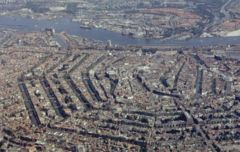Amsterdam

Amsterdam is the constitutional capital and the largest city of the Netherlands (inhabitants in 2007 ca. 743,100). In 2007 the city housed 175 different nationalities. About 122,000 inhabitants had a double nationality (Dutch and non-Dutch). In 2007 ca. 65,000 inhabitants were Moroccan and 37,000 Turkish.[1] The Amsterdam region has about 2 million inhabitants. This is the region between Alkmaar, Zaanstad and Purmerend to the north, Almere and Diemen to the East, Abcoude, Amstelveen, Hoofddorp to the south, and Haarlem and IJmuiden to the west. Amsterdam is situated mainly on the south bank of the IJ—the IJ being the mouth of the short river Amstel (after which Amsterdam is named) on the IJsselmeer (the former Zuiderzee). Amsterdam is connected with the North Sea by the North Sea Canal (opened in 1876), which accommodates ocean-going vessels. The Amsterdam-Rhine canal (1952) connects Amsterdam with the Rhine river and thus with Nordrhein-Westfalen the largest (in population) and one of the most heavily industrialized Bundesländer (states) of Germany. Schiphol Airport (also known as Amsterdam Airport), a few miles south of Amsterdam in the municipality Haarlemmermeer, is the largest Dutch airport and ranks number 12 in the world with respect to number of passengers.
Because of its soft, wet, and peaty soil the inner city is built on wooden piles and is cut by about 40 concentric and radial canals (in Dutch called grachten) flanked by streets and crossed by some 400 bridges. Thus, Amsterdam is sometimes referred to as Venice of the North. Many of the large picturesque houses along the canals are former patrician dwellings and are now in use as office buildings. The canals with their bridges give Amsterdam an unmistakable character nowhere else to be seen in the world.
History
In the 13th century a Dam was built in the river Amstel, after which fishermen and tradesmen settled around it. The oldest written referral to the city is in a document of 1275, in which Floris V, count of Holland, gives the burghers of Amsterdam freedom of toll. It is likely—but not without doubt—that Amstelledam, as the city was then called, was chartered in 1306 by the Bishop of Utrecht. Soon after (1369) Amsterdam joined the Hanseatic League and became one of the most important trade centers in Holland. In 1568 the Netherlands rose against the king of Spain, Philip II, who inherited the country from his father, the Habsburg emperor Charles V. Amsterdam did only join the revolutionaries ten years later in 1578. After the Flemish city Antwerp, that had joined the rebellion, was reconquered by the Spanish, many Flemish tradesmen fled to Amsterdam. They were soon joined by many well-to-do Portuguese Jews (often from Spanish descent), who were expelled from their country. This influx of foreigners caused an economic boom and Amsterdam developed into one of the most important cities of Europe in the middle of the seventeenth century. These were the days that the large patrician houses along the canals were built.
In the eighteenth century the flowering of the city stagnated and the number of inhabitants shrunk steadily. The fourth sea war with the English (1780-1784) and the British blockade of Napoleon's Europe gave the final blows to the city as one of Europe's most important trade centers.
In the 19th century the economy was revived by the opening of the North Sea Canal (1876) and the arrival of the industrial revolution. Amsterdam started extending outside its 17th century boundaries. The Rijksmuseum, the central train station, and the Concertgebouw were built. The old school Athenaeum Illustre (founded in 1632) was upgraded (1877) to the Municipal University (now the University of Amsterdam). In the 1920s Amsterdam extended to the south (plan Berlage), but during the economic depression of the 1930s Amsterdam was heavily hit.
On 15 May 1940 Nazi Germany occupied the city. A large part of the city went on strike spontaneously on 25 February 1941 in reaction to the German measures taken against the Jewish population of Amsterdam. After the battle of Arnhem (mid September 1944) until the liberation by the Allied forces (May 8 1945) there was a famine in Amsterdam and its surrounding region. It is estimated that during this winter 25000 people died of starvation. About 110,000 Jews were deported from the Netherlands to concentration camps, the majority of them from Amsterdam. Only about 5,500 Dutch Jews returned; the rest died in the Nazi camps.[2]
From the 1960s onward Amsterdam prospered again and once more saw a great influx of immigrants. It became an important center of the developing mass tourism, not only because of its museums (Rijksmuseum, Stedelijk Museum, Van Gogh museum) and its canals, but also, especially for younger tourists, because of the Dutch tolerance on soft drugs and Amsterdam's famous red light district.